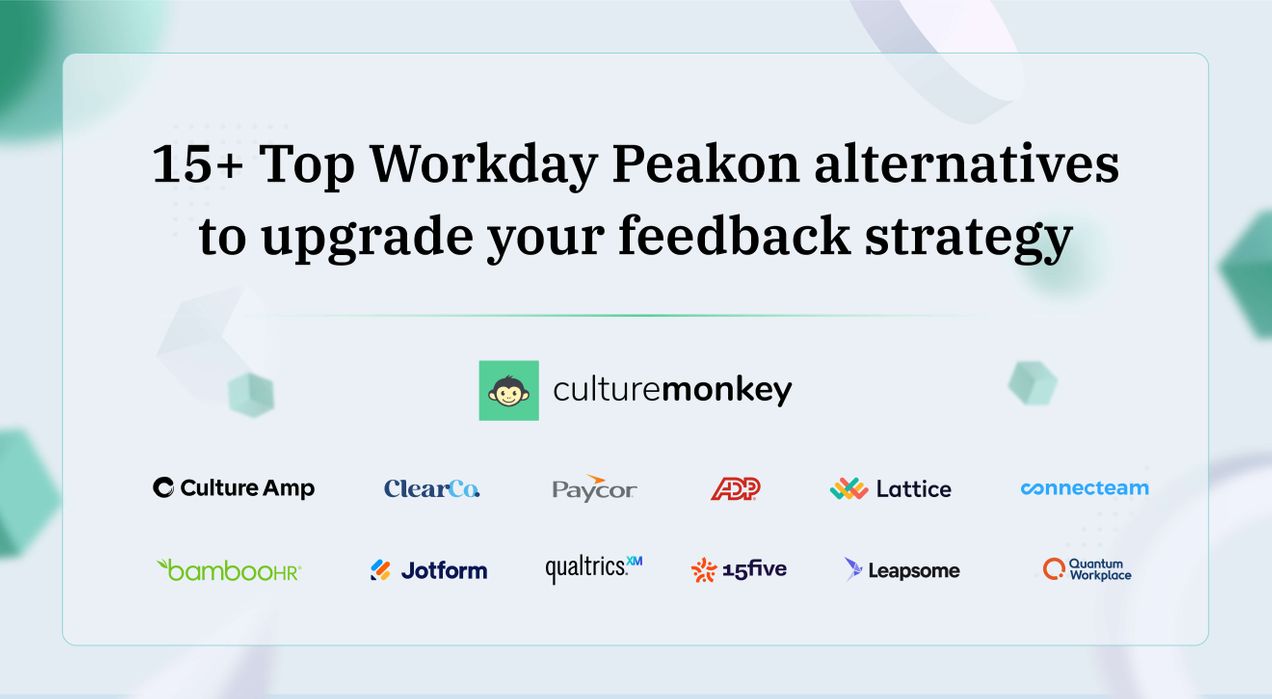20 Employee engagement survey ideas to get honest and actionable feedback in 2025

Picture a vending machine. You press the button, craving your favorite snack. The lights flash, the machine hums, but nothing drops.
You try again. Still nothing. Eventually, you give up. You might even stop trusting that machine altogether. That’s the frustration employees feel when they share honest feedback and nothing changes.
It’s not just about the snack—it’s about the broken promise. The expectation of something in return. That tiny moment of being let down chips away at trust. Over time, people stop pressing the button.
They stop speaking up. But when does feedback lead to action? That’s when belief is restored—and people start showing up again, with honesty, hope, and energy.
TL;DR
Why are employee engagement surveys critical for HR in 2025?

TL;DR
Engagement surveys reveal early signs of burnout, disengagement, and morale dips, enabling HR to act before issues spread. They replace guesswork with actionable data, guiding benefits, policies, and inclusion strategies.
They empower managers with team sentiment insights, strengthen remote connections, and reinforce trust when feedback leads to visible change. This ongoing loop boosts retention and aligns the workforce with evolving company culture.
With hybrid work, evolving tech, and rising employee expectations, HR needs sharper tools to keep up. That’s why employee engagement survey ideas matter more than ever—they help you hear what’s not being said, measure employee engagement outcomes, and ultimately improve employee retention.
- Disengagement can be identified before it spreads: An engagement survey is often the first place where signs of burnout, stress, or demotivation appear. These early clues give HR the chance to address root issues before they evolve into low productivity, absenteeism, or resignations.
- Employees are more likely to speak up when they feel heard: When teams know their feedback isn’t disappearing into a black hole, they respond with honesty. Creating a visible feedback loop—where suggestions lead to changes, fosters trust, openness, and continued participation.
- Decision-making becomes more aligned with employee needs: Guesswork is replaced by real data. Using smart engagement survey questions, HR can prioritize benefits, policies, and support systems that actually reflect employee expectations, not just leadership assumptions.
- Inclusion goals become measurable and more impactful: With survey results segmented by role, location, or demographics, HR gains deeper insight into how different employees experience the workplace. That clarity leads to more meaningful diversity, equity, and inclusion efforts.
- Managers gain visibility into team sentiment: Using relevant employee feedback survey examples, leaders at every level can better understand what’s happening on their teams. This insight drives more empathetic communication and proactive problem-solving.
- Remote and hybrid employees stay meaningfully connected: Great survey ideas for remote teams can help bridge the physical distance. Regular check-ins via surveys keep distributed employees aligned with company culture and ensure their challenges aren’t overlooked.
- Feedback becomes the foundation for visible change: Surveys are most valuable when they’re part of broader workplace survey strategies, where insights are followed by action. That consistency builds trust and shows employees their voices are shaping the future of work.
What makes a good employee engagement survey?

Not all surveys are created equal. A good employee engagement survey isn’t just a list of questions—it’s a structured, thoughtful conversation starter that encourages honesty, boosts employee motivation, and supports professional development.
Here’s what separates effective surveys from forgettable ones.
Clear purpose drives better responses
Surveys should have a defined goal—whether it’s understanding morale, improving communication, or exploring workload issues. When employees know why they’re being asked, they’re more likely to engage sincerely and share their true feelings about employee happiness.
Questions need to be specific but not limiting
Broad questions lead to vague answers. Using targeted employee engagement survey questions helps uncover actionable insights while still giving employees room to express their unique experiences.
Balance between ratings and open-ended responses matters
Likert scales are easy to analyze, but adding space for comments deepens understanding. Combining the two helps capture both trends and context, something every great employee experience survey needs to provide critical insights.
Language must feel approachable, not corporate
Avoid jargon and HR-speak. Surveys should feel like a conversation, not a compliance task. Using relatable language makes feedback feel safe and personal, especially in employee feedback survey examples, and helps address concerns about work-life balance.
Trust and anonymity are built-in, not optional
Surveys that guarantee confidentiality create space for honesty. This is particularly important when exploring sensitive topics related to employee perceptions, career development, or when collecting input from distributed teams using survey ideas for remote teams.
Key goals to define before designing your survey

Before diving into question lists and fancy survey tools, it’s crucial to step back and define what you want to learn. A well-designed survey starts with clear goals that shape every question and help turn answers into action, including insights about future career aspirations. Here are six you shouldn’t skip.
- Understand overall employee engagement levels: One of the core goals is to gauge how connected, motivated, and satisfied your employees feel at work. This insight becomes the foundation for crafting focused employee engagement survey ideas that reveal what’s driving or dragging employee net promoter score or employee satisfaction.
- Identify strengths and gaps in company culture: Surveys can uncover what employees love about your culture and where they feel misaligned. This helps HR adjust messaging, values, or behaviors to ensure they match the actual employee experience.
- Evaluate the effectiveness of leadership and communication: Whether it’s feedback loops or clarity from managers, understanding how leadership is perceived matters. Smart engagement survey questions can expose gaps that lead to miscommunication or mistrust.
- Improve team dynamics and collaboration: A good survey should aim to uncover friction points within or between teams. This is especially useful when using employee feedback survey examples tailored to specific departments or roles.
- Measure the impact of recent initiatives or changes: If you've rolled out new benefits, tools, or policies, use your survey to assess how those changes are landing. This makes surveys part of continuous workplace survey strategies rather than one-time events.
- Capture the remote and hybrid work experience: For teams working outside the office, use your survey to understand how supported they feel. Incorporating survey ideas for remote teams ensures you’re not overlooking challenges unique to distributed work.
20 Employee engagement survey ideas to improve participation and honesty

Getting honest feedback isn’t just about asking questions—it’s about how you ask them. If your surveys feel like a chore or sound like a legal disclaimer, don’t expect meaningful insights.
These 20 employee engagement and satisfaction survey ideas are designed to encourage real participation, spark reflection, and build trust, ultimately leading to meaningful feedback in 2025.
- Start with a warm, human intro: Use a conversational opening that explains why the survey matters and how responses will be used. This sets a tone of transparency.
- Ask one question per screen: Keep things uncluttered and focused. Employees are more likely to answer honestly when they aren’t overwhelmed with text blocks.
- Use emojis or mood sliders: Visual scales (like 😊😐☹️ or mood bars) make questions feel lighter, more intuitive, and ideal for pulse-style employee experience survey check-ins.
- Include open-ended follow-ups: Pair rating questions with an optional “Why?” This gives context to scores and makes your engagement survey questions more actionable.
- Keep the tone casual, not corporate: Ditch robotic phrases like “Rate your satisfaction with organizational communication cadence.” Just say, “How clearly do you feel leadership communicates?”
- Offer “skip” options without guilt: Let people opt out of questions that don’t apply. This builds trust and avoids forcing fake responses.
- Use real-life scenarios: Instead of abstract questions, frame them around actual workday situations. These feel more relatable and yield clearer answers.
- Ask what should change—not just what’s wrong: “Name one thing we could improve by next month” feels more actionable than “What don’t you like?”
- Keep it short (10 questions max for pulse surveys): No one likes a never-ending form. Brevity encourages higher completion and less rushed responses.
- Allow employees to write in their own words: Open-text fields invite nuance, which many structured employee feedback survey examples miss. You’ll often find your best insights here.
- Rotate in fun, unexpected questions: Try “What’s something you wish we knew about your workday?” These add freshness and invite honesty.
- Include questions about how the survey feels: Meta, but useful—ask if the survey itself felt easy, respectful, or worth answering. It shows you value their time.
- Offer an anonymous option every time: Especially for sensitive topics, anonymous surveys help build psychological safety and transparency.
- Ask about the team, not just company-level experience: “How supported do you feel by your team?” gives insights that broader workplace survey strategies can miss.
- Add a recognition prompt: A quick “Who deserves a shoutout?” lets positivity flow in and encourages engagement across roles.
- Crowdsource questions from employees: Ask employees to submit one question they’d want everyone to answer. It creates buy-in and relevance.
- Break questions into themes: Group related items (e.g., leadership, communication, wellbeing) so the survey feels organized and not random.
- Include one forward-looking question: Try “What’s one thing you’re excited about in the next quarter?” to balance out the problem-focused tone.
- Share estimated completion time up front: If it only takes 5 minutes, say so. This transparency reduces resistance and increases completion rates.
- Customize questions by role or department: Tailored surveys—especially for hybrid teams or frontline workers—make feedback feel personalized and relevant. Perfect for using survey ideas for remote teams or department-specific insights.
How to create surveys that employees actually want to answer?
TL;DR
Set clear “what’s in it for me” upfront, keep surveys under 10 minutes, and use natural language that avoids jargon. Engaging formats like sliders and quick selects keep attention high.
Ensure anonymity when needed, use visuals for better UX, and always close the loop with shared results and action plans. Respecting time, tone, and transparency drives authentic participation.
If a survey feels like a task, it’s going straight to the “I’ll do it later” pile, which we all know means never. To get authentic, useful responses, your survey needs to feel worth the time. Here’s how to design a survey that employees are happy to click through.
- Start with the “what’s in it for me” upfront: Kick things off with a short, sincere explanation of why you’re running the survey and how their feedback will be used. When people see the impact of their input, they’re more likely to engage.
- Keep it short and respectful of time: The sweet spot? 5–10 minutes max. Even your most engaged employee won’t appreciate a 40-question scroll-fest. Shorter surveys signal that you respect their time and attention span.
- Ask questions that sound like humans wrote them: Ditch corporate lingo and use language that sounds natural. Instead of “Evaluate the efficiency of operational workflows,” ask, “How easy is it to get your work done each day?”
- Mix in engaging formats: Use a blend of rating scales, quick selects, and open text. This variety keeps attention high and mirrors the style of the best employee feedback survey examples today.
- Make it anonymous where needed: Want honesty? Anonymity helps. Especially when dealing with sensitive topics, private responses allow employees to speak freely without fear of judgment or backlash.
- Use visuals or micro-interactions: Mood sliders, quick icons, and progress bars can make even a serious employee experience survey feel less dry. These little touches improve user experience and reduce drop-off rates.
- Always close the loop after the survey: No one wants to give feedback that disappears into a void. Summarize key findings and share your action plan. It turns feedback into change, and makes future participation a no-brainer.
Open-ended questions that give deeper insights

Yes-or-no checkboxes only go so far. If you really want to understand how employees feel, think, and experience the workplace, you need to give them room to speak in their own words.
These 15 open-ended employee engagement survey ideas are designed to dig deeper, uncover what numbers alone can’t, and assess the need for new skills.
- What’s one thing you enjoy most about working here?
- If you could change one thing about your daily work experience, what would it be?
- What’s something that leadership could do to better support you?
- When do you feel most motivated at work—and why?
- What’s one thing that’s been frustrating or slowing you down lately?
- How supported do you feel by your manager or team lead?
- Is there a process or tool that you think needs improvement?
- What’s something you wish we understood better about your role?
- How would you describe our company culture to a new hire?
- What’s one thing the company could do to improve your well-being?
- What helps you stay connected while working remotely or in hybrid mode? (Great for survey ideas for remote teams)
- What’s a recent company change or initiative you found helpful (or unhelpful)?
- If you had one suggestion to improve communication here, what would it be?
- What makes you feel most recognized or appreciated at work?
- Is there anything else you’d like to share that we haven’t asked about?
Anonymous surveys: Why they increase trust and transparency
TL;DR
Anonymity encourages honesty, especially on sensitive topics like leadership and workload. This psychological safety delivers more accurate, unfiltered insights that drive meaningful change.
Over time, consistent anonymous surveys prove the company listens without retaliation, strengthening trust, transparency, and participation in future feedback efforts. Leaders gain reliable data for better decision-making.
Let’s face it—employees won’t be fully honest if they think their feedback might come back to bite them. Anonymity removes that fear and makes room for real talk. That’s why the best employee engagement survey ideas in 2025 are built on the foundation of anonymous responses that reflect the workplace culture.
- Honest feedback becomes more likely: When employees know their names aren’t attached, they’re far more likely to share their true opinions. This opens the door to raw, unfiltered insights that closed-door conversations might never reveal.
- Sensitive topics can be addressed safely: Concerns about leadership, workload, or team dynamics are hard to share openly. An anonymous survey creates a safe space, especially when asking tougher engagement survey questions or gathering feedback from vulnerable groups.
- Employees feel psychologically safer: Anonymity signals that the organization values input without judgment. This fosters a sense of safety that builds over time, increasing trust in future surveys and other workplace survey strategies.
- Leaders gain more accurate insights: When the fear of being identified is removed, survey data becomes more reliable. You’re not just collecting polite answers—you’re capturing how employees feel.
- Long-term transparency improves: Over time, consistently anonymous surveys demonstrate that the company listens and acts on feedback without retaliating. This strengthens your overall employee experience survey approach and builds a feedback-positive culture.
How to align survey ideas with company culture and values?
TL;DR
Mirror your internal tone, ask questions tied to lived values, and customize by team to reflect real experiences. Inclusion-focused questions reveal whether values serve all employees.
Include open-text for culture stories and follow up with actions that embody values. Aligning surveys with culture boosts authenticity, relevance, and employee engagement.
If your surveys feel disconnected from your company’s mission, employees will spot the mismatch instantly. To get honest answers, your employee engagement survey ideas need to reflect the culture you preach and the values you live by. Here’s how to make that connection real.
- Use language that mirrors your internal tone: If your culture is casual and open, your survey shouldn’t sound like a legal memo. Aligning the tone of your engagement survey questions with your internal communication style helps employees feel more at ease while answering.
- Ask about behaviors tied to company values: Instead of just asking if someone feels “engaged,” try asking, “How often do you see our core values in action?” This anchors your survey in real behaviours—not vague impressions.
- Customize questions by team or function: Different teams experience culture differently. Tailoring questions ensures that your survey reflects how values play out in practice, whether on a sales floor or in a remote tech team. Perfect for survey ideas for remote teams too.
- Include open-text space for culture comments: Invite employees to describe what your culture feels like in their own words. These comments often reveal whether your company values are just posters on the wall, or something lived day to day.
- Highlight diversity and inclusion within cultural questions: Culture isn’t one-size-fits-all. Including questions that touch on belonging, inclusion, and equity helps you understand how well your values serve all employees, key to building thoughtful workplace survey strategies.
- Follow up with visible actions that reflect your values: If transparency is a core value, share the results openly. If growth matters, show how you’re using feedback to develop employees. The post-survey action plan should walk the cultural talk.
Department-specific survey ideas (Marketing, IT, Sales, etc.)
Every department experiences engagement differently. What matters to a sales rep might be totally irrelevant to a backend developer. Customizing your employee engagement survey ideas by department helps capture more relevant, honest feedback from team members. Here are seven tailored ideas for key teams.
1. Marketing – Ask how aligned campaigns feel with the company direction
Marketing teams want to know their work has a purpose. Try asking, “Do you feel our marketing efforts reflect the company’s mission and values?” This gauges both clarity and creative alignment.
2. IT – Check for support, tools, and workload balance
IT teams often carry invisible stress. Ask, “Do you feel equipped with the right resources and time to meet internal tech demands?” This question highlights gaps in tools or unrealistic expectations.
3. Sales – Explore recognition and target pressure
Sales culture can get intense. Try asking, “Do your performance targets feel realistic and well-supported by leadership?” It's a great way to combine employee feedback survey examples with mental well-being checks.
4. Customer Support – Ask about emotional workload
Support teams deal with front-line frustrations. Ask, “How supported do you feel in managing difficult customer interactions?” This helps assess emotional exhaustion and overall team morale.
5. HR – Evaluate whether they feel heard within leadership
HR professionals are often expected to support others without voicing their own struggles. Ask, “How confident do you feel in influencing decisions that affect employee wellbeing?”
6. Product – Gauge collaboration and ownership
Product teams juggle multiple inputs. A question like, “Do you feel your ideas and feedback influence the final product decisions?” taps into engagement through ownership and collaboration.
7. Finance – Focus on cross-functional communication
Finance often works behind the scenes. Ask, “Do you receive the information you need from other departments in a timely and accurate way?” This improves alignment with company goals and efficiency across teams, vital for broader workplace survey strategies.
Best practices for timing and frequency of employee surveys

When it comes to surveys, timing can make or break participation. Send too often, and people tune out. Wait too long and you miss key moments. To get the most from your employee engagement survey ideas, follow these smart, well-paced best practices.
1. Send pulse surveys quarterly, not monthly
Quarterly surveys strike the right balance—they’re frequent enough to track trends but not so often that they feel repetitive. They’re ideal for light check-ins using targeted engagement survey questions.
2. Time surveys after major milestones
Send surveys after product launches, org changes, or policy rollouts. This lets you measure the impact while the experience is still fresh, especially when using employee feedback survey examples for context.
3. Avoid peak stress periods (like quarter-end)
Launching a survey when teams are buried in deadlines guarantees low participation. Aim for quieter periods when employees can actually reflect and respond thoughtfully.
4. Use calendar consistency
If your surveys come out around the same time every year or quarter, employees start to expect them. This predictability builds a feedback rhythm that supports long-term workplace survey strategies.
5. Keep surveys short for mid-cycle check-ins
For bi-monthly or monthly pulse checks, limit questions to 5–7. This ensures high completion rates without survey fatigue, especially when designing survey ideas for remote teams who juggle different schedules, and can be coordinated around a team event.
6. Always close the loop before launching the next one
Don’t send a new survey until you’ve shared results from the last one. When employees see their input lead to action, they’re more likely to keep participating.
7. Consider team-specific timing
Different departments have different busy seasons. Customize survey timing for roles like Sales (post-quarter), Marketing (post-campaign), or IT (after big deployments) to catch more thoughtful and relevant insights.
Common mistakes to avoid when designing engagement surveys
Even the best employee engagement survey ideas can fall flat if the design is off. From confusing questions to radio silence after the survey closes, small missteps can lead to low trust and even lower participation. Here are six common mistakes to steer clear of.
- Making the survey too long: If a survey takes 25 minutes to complete, most people won’t bother—or they’ll rush through it. Keep it concise and focused. Long surveys lead to fatigue and half-hearted responses that don’t reflect the real employee experience.
- Using vague or leading questions: A question like “Don’t you agree our leadership is supportive?” will skew results. Questions should be neutral and clear. Good engagement survey questions invite honesty, not just validation of what leadership hopes to hear.
- Forgetting to include open-ended responses: Relying solely on multiple-choice means you’ll miss out on context. Open-ended fields, like those in strong employee feedback survey examples, allow employees to explain their ratings and offer new ideas.
- Ignoring the needs of remote and hybrid teams: If your questions only focus on in-office experiences, you alienate a big chunk of your workforce. Include thoughtful survey ideas for remote teams that reflect their unique challenges and environment.
- Not offering anonymity: Without an anonymous option, employees may sugarcoat or skip honest feedback—especially on sensitive topics. Confidentiality builds trust and leads to more truthful responses.
- Failing to share results or take action: Nothing kills participation faster than silence after submission. Sharing survey outcomes—and your response plan—is essential for any long-term workplace survey strategies to succeed.
The role of AI and analytics in engagement survey design

In 2025, AI and analytics aren’t just buzzwords—they’re transforming how companies listen to their people. When used right, they take employee engagement survey ideas from basic to brilliant, helping HR teams design smarter surveys and act faster on feedback.
- Personalize survey questions based on employee data: AI can analyze role, tenure, or past responses to tailor questions for each employee. This customization makes engagement survey questions more relevant and increases the chances of honest participation.
- Predict disengagement before it happens: By spotting patterns in survey responses, AI tools can flag at-risk teams or individuals. This proactive approach helps HR intervene early—before frustration turns into turnover.
- Analyze open-ended responses at scale: Instead of manually sorting hundreds of comments, AI-powered text analysis clusters themes, emotions, and keywords. This gives deeper insight into employee experience survey responses without losing nuance.
- Optimize survey timing and frequency: AI learns when employees are most likely to respond and recommends the best times to send surveys. This boosts completion rates and reduces fatigue, especially helpful in workplace survey strategies.
- Track trends over time with real-time dashboards: Advanced analytics help HR visualize engagement shifts across departments, demographics, or geographies. It’s especially useful when testing different employee feedback survey examples or formats.
Tools and platforms to create better surveys in 2025
In 2025, survey tools are smarter, faster, and more employee-friendly.
With AI-powered insights, automation, and real-time analytics, platforms are redefining how HR leaders gather and act on feedback that directly impacts the company's success. Here's a look at the top tools to help you create surveys that employees actually want to answer.
1. CultureMonkey
CultureMonkey is enterprise purpose-built to elevate employee engagement through smarter surveys. In 2025, it stands out with AI-driven templates, advanced analytics, and native integrations with platforms like Slack and Teams, making feedback collection effortless and insightful.
Its anonymity engine encourages honest responses, while automation ensures teams stay in sync without overwhelming employees. Here's what makes it a standout choice:
- AI-generated survey templates: Create well-structured, bias-free surveys in seconds.
- Real-time analytics dashboard: Monitor responses and trends as they happen for quicker decision-making.
- Seamless integrations: Deploy surveys directly via Slack, Microsoft Teams, Gmail, and more.
- Anonymity engine: Build trust and increase participation with secure, anonymous feedback collection.
- Automated survey workflows: Set up recurring pulse, eNPS, or lifecycle surveys without manual intervention.
- Multilingual survey support: Engage global teams in their native languages for accurate insights.
- Role-based dashboards: Provide HRs, managers, and leaders access to relevant survey data.
- Sentiment analysis: Decode the emotional tone behind employee responses using AI.
- Pre-built action plans: Turn insights into impact with suggested next steps tailored to your results.
- Survey fatigue detection: Automatically manage cadence and timing to prevent over-surveying.
- Custom segmentation: Target surveys by role, department, tenure, or location for deeper insights.
2. Qualtrics
Qualtrics remains a leader in experience management with robust survey capabilities. It offers advanced logic, branching, and dashboards to monitor sentiment in real time. Its predictive analytics help HR leaders proactively address disengagement and turnover, especially in large or global organizations.
3. Peakon (by Workday)
Peakon stands out by connecting employee sentiment with KPIs like retention and productivity. Its machine learning engine categorizes open-ended responses and benchmarks data across industries. The platform’s auto-generated action plans are a game-changer for busy people managers.
4. Officevibe
Officevibe makes it easy to send weekly pulse surveys with questions backed by organizational psychology. It delivers instant, actionable insights to managers—along with coaching tips to improve team culture. The tool’s simplicity and focus on small team dynamics make it ideal for fast-growing companies.
How to follow up on engagement survey results effectively
TL;DR
Share results transparently, host team-level discussions, and co-create solutions with employees to build ownership. Assign clear responsibilities and timelines to ensure momentum.
Provide regular progress updates via newsletters, dashboards, or huddles. This visibility reinforces trust, shows commitment to continuous improvement, and encourages ongoing participation in future surveys.
Running a survey is only half the battle—what you do afterward truly defines your engagement strategy. Employees want to know their feedback matters, and nothing kills trust faster than silence. Here are five practical ways to follow up on engagement survey results that build credibility, drive action, and encourage participation among employees.
- Share the results transparently, even if they're not glowing: Being honest about what employees shared, good or bad, sets the tone for trust. Summarize key insights and share them with the entire team in a clear, jargon-free format. This shows that you're listening, not just collecting data.
- Host team-level discussions to contextualize feedback: Bring managers and teams together to discuss department-specific results. This lets people voice thoughts behind the numbers and brainstorm improvements collectively. It's a powerful step toward turning feedback into dialogue.
- Co-create action plans with employee input: Instead of top-down fixes, invite employees to help shape the solutions. Whether it’s through focus groups, suggestion boards, or task forces, co-creating action plans builds ownership and accountability.
- Assign owners and timelines to keep momentum alive: Once priorities are set, assign clear responsibilities and timelines. Whether it's HR, team leads, or specific departments, people need to know who’s doing what—and by when—for change to actually happen.
- Close the loop regularly with visible progress updates: Don't let the energy fade after the survey buzz. Use newsletters, dashboards, or team huddles to update everyone on actions taken and what's next. It signals you're serious about continuous improvement, not just ticking a box.
Conclusion
Following up on engagement survey results isn’t just a nice-to-have—it’s where the real impact begins.
Employees want to know that their feedback leads to action, not just another dashboard. From transparent communication to shared accountability, how you respond determines whether people feel heard or unheard. The most engaged teams aren’t just surveyed, they’re included in every step that follows.
That’s where CultureMonkey comes in. With powerful analytics, automated follow-up tools, and customizable feedback workflows, CultureMonkey helps HR teams close the loop quickly and meaningfully.
Whether you're acting on big insights or small wins, CultureMonkey makes it easier to turn feedback into follow-through. Start building a culture where every response matters and every action counts.
Summary
FAQs
1. How can I make employee surveys more engaging?
To make employee surveys more engaging, keep them short, relevant, and easy to complete. Use a mix of question types, add open-ended prompts, and ensure mobile accessibility. Personalize the survey to align with employees’ roles and the current company context. Most importantly, follow up on results—engagement drops fast if people feel their input goes nowhere.
2. What questions should I include in an engagement survey?
Include questions that touch on core engagement drivers like recognition, growth opportunities, leadership, communication, and alignment with company values. Use a balance of rating-scale and open-ended questions. For example, ask, “Do you feel valued for your work?” and “What could we improve in team communication?” These help you uncover both measurable trends and valuable context behind employee sentiments.
3. Are pulse surveys better than annual surveys?
Pulse surveys are often better than annual employee engagement surveys for tracking real-time sentiment and responding faster. They're shorter, more focused, and less fatiguing for employees. While annual surveys provide a broader snapshot, pulse surveys help spot trends and test interventions. Ideally, combine both—use pulse surveys for agility and the annual survey for comprehensive benchmarking and planning.
4. How can anonymous surveys improve employee feedback?
Anonymous surveys encourage employees to share honest opinions without fear of judgment or consequences. They’re especially effective for uncovering sensitive issues like burnout, leadership challenges, or toxic culture signals. When employees feel safe, they’re more likely to provide meaningful, constructive feedback that HR and leadership can actually use to make impactful changes.
5. Which tools are best for creating employee engagement surveys?
Top tools for engagement surveys include CultureMonkey, Qualtrics, SurveyMonkey, Officevibe, and Glint. These platforms offer templates, analytics, anonymity options, and easy integration with HR systems. CultureMonkey stands out for its simplicity, automation features, and actionable insights tailored for HR leaders. The right tool should make feedback collection seamless and follow-up easier to manage.



